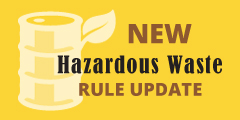The Environmental Protection Agency (EPA) will begin implementation and operation of the e-Manifest system on June 30, 2018. The e-Manifest requirements will be effective in all states on this date affecting to those required to use a hazardous waste manifest–generators; transporters; owners and operators of treatment, storage and disposal facilities (TSDF); and handlers of state-only…
Category: Hazardous Waste

Changes to Hazardous Waste Regulations
On November 28, 2016, the Environmental Protection Agency (EPA) issued a final rule that significantly revises hazardous waste generator regulations. These revisions provide less stringent requirements for many hazardous waste generators and become effective on May 17, 2017. The revised regulations are intended to improve compliance and program effectiveness, clarify existing regulations, address regulatory gaps,…
Not all bulbs are created equally
In the last post I summarized requirements for universal waste. One waste stream that falls into this category are bulbs (lamps). Did you know that not all lamps need to be managed as universal waste that, in fact, some are not even classified as hazardous waste or universal waste?
Universal Waste Requirements
Universal waste is a special category of hazardous waste that includes batteries, pesticides, mercury-containing equipment and lamps. For the most part, these wastes are self-explanatory but often confusion arises from mercury-containing equipment which includes a device or part of a device (including thermostats, but excluding batteries and lamps) that contains elemental mercury integral to its function. Some…
The Devil is in the Details…Hazardous Waste Training Requirements
In this series on hazardous waste we have discussed: defining hazardous waste; managing hazardous waste at home; determining generator status; hazardous waste accumulation and storage requirements. This article will review training requirements, one of the biggest violations that companies incur. The amount and type of training required is based upon the generator status of the company. …
The Devil is in the Details…Hazardous Waste Accumulation Areas
I have discussed identifying hazardous waste in What is Hazardous Waste? and determining hazardous waste generator status in The Devil is in the Details…What Type of Generator are You? Today we will tackle the issue accumulation time–the amount of time a hazardous waste generator is allowed to store hazardous waste on site. These requirements are…
The Devil is in the Details…What Type of Generator are You?
In What is Hazardous Waste? I talked about properly identifying hazardous waste by asking 10 key questions. Now that you have tools to identify hazardous wastes what are the next steps in managing hazardous waste in compliance with federal regulatory requirements? The RCRA regulations applicable to a particular business are based upon the amount of…
Managing Hazardous Waste at Home
Much discussion is centered around toxicity in our homes—chemicals in our cleaning products; cancer-causing materials in our cosmetics and skin care products. I recently read an article published in Globe and Mail entitled “Your manicure looks beautiful. But the health effects are ugly” about the occupational hazards associated with nail salons. The article highlighted…

What is Hazardous Waste?
Hazardous waste is one of the most regulated arenas within environmental compliance. Many industries and service providers utilize chemicals in their processes and the disposal of these materials is what creates hazardous wastes. Proper disposal is an important part of ensuring the cleanliness of our waters, soil, and air. Hazardous wastes are dangerous to the…
